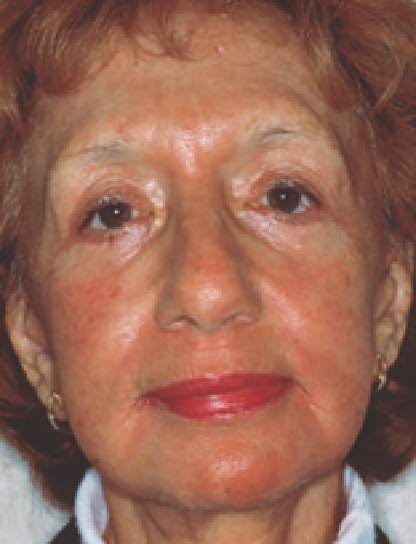Biomedical Engineering Reference
In-Depth Information
(
A
)
(
B
)
Figure 6.28
Anticipated improvement results for full-face resurfacing are 50-70%. Complete elimination of some wrinkle lines defi nitely will occur, but other lines
may only soften. (
A
) Before surgery; (
B
) 3 months postoperatively.
Sun-damaged skin, with a history of decades of sun expo-
sure, has a different pigmentation than non-sun-damaged
skin that is related to the depth of resurfacing. Removal of the
epidermis alone may result in healing with a population of
melanocytes derived from the most superfi cial aspect of the
follicular epithelium. These melanocytes have a signifi cant
history of prior sun damage and may produce persistent dys-
pigmentation. Deeper resurfacing results in progressive elimi-
nation of this sun-exposed subset of follicular epithelial
melanocytes, yielding a more uniform pigmentation. An effec-
tive means of communicating this to patients is to have them
compare the pigment of a non-sun-exposed area, such as the
skin of the medial upper arms, to that of their face. This is
likely to be the color of their newly healed skin, with non-sun-
exposed epithelium and papillary dermis having developed
during the healing process. If a strong color contrast is seen, a
decision must be made regarding (
i
) selection of epidermal
resurfacing only, which can be accomplished with a 20% TCA
peel or Er:YAG laser resurfacing and (
ii
) consideration of
forming the transition zone from treated to nontreated skin.
The natural shadowing under the jawline makes this area a
good transition area. For some patients, the contrast will be
too great if they do not wear makeup. It may be preferable,
however, to have this contrast occur at the jawline rather than
at midneck (chosen by some physicians because the upper
neck heals better than the lower neck and can be treated more
aggressively), the clavicular level, or the V of the neck or upper
chest. Resurfacing of the neck to the clavicles or down to the
middle anterior chest is diffi cult and should only be performed
by those who are experienced and have a mastery of laser-
tissue interaction (Fig. 6.29) (40). The erbium laser may also
be used successfully in this regard with proper technique.
Some physicians use 20-25% TCA applied in a light coat, with
only spotty frosting occurring. The latter two choices may be
appropriate for a woman who always wears a collared shirt and
rarely or never has her entire upper chest and shoulder area
visually exposed. When these areas are more visible from the
clothing worn, especially in those frequently involved in ath-
letics, women may prefer more superfi cial resurfacing and a
transition zone at the jawline.
To preserve normal pigmentation, although it may be
reduced in contrast to sun-damaged skin, it is necessary to
avoid deep, midreticular dermal tissue removal. This type of
pigment loss is considered a complication and is usually asso-
ciated with prolonged erythema (Fig. 6.30). It should be avoid-
able through adherence to our recommended techniques.
Lines of Expression
Lines of expression—forehead lines, glabellar lines, and, par-
ticularly, “crow's feet” lateral canthal lines—are caused by mus-
cle contraction and will always recur, even if completely erased
after the procedure. As long as the muscles involved continue
to fold the skin, a crease is formed. Several surgical procedures
may be used to denervate or demuscle some of these areas.
However, a very useful adjunctive procedure is the injection of
botulinum toxin type A (Botox/Dysport/Xeomin) to block
nerve transmission to these muscle groups (137-140). These
injections should be performed 1-2 weeks preoperatively to
block these muscle groups and prevent motion in these areas
for 3-4 months during the time of new collagen formation and
remodeling. Enhanced results are seen and should give a more
lasting clinical improvement (Fig. 6.31). We recommend con-
tinuing with Botox injections every 3-4 months for 1 year to
achieve longer-lasting results.


















